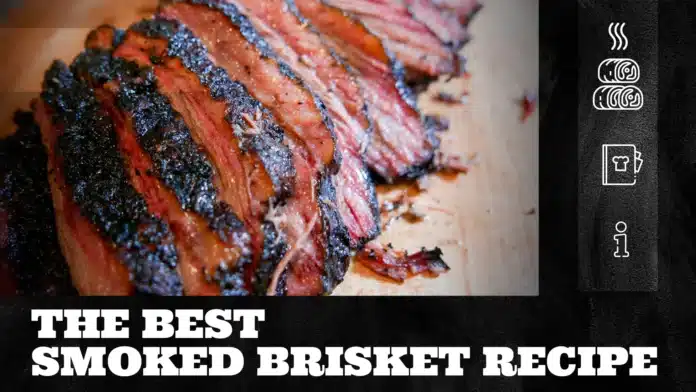The art of crafting a mouthwatering smoked brisket is a journey that takes us through the heart of barbecue culture, from selecting the right cut of meat to mastering the art of smoking.
Join us as we delve into the world of smoked brisket recipes, where smoky aromas and savoury indulgence converge to create a culinary experience like no other.
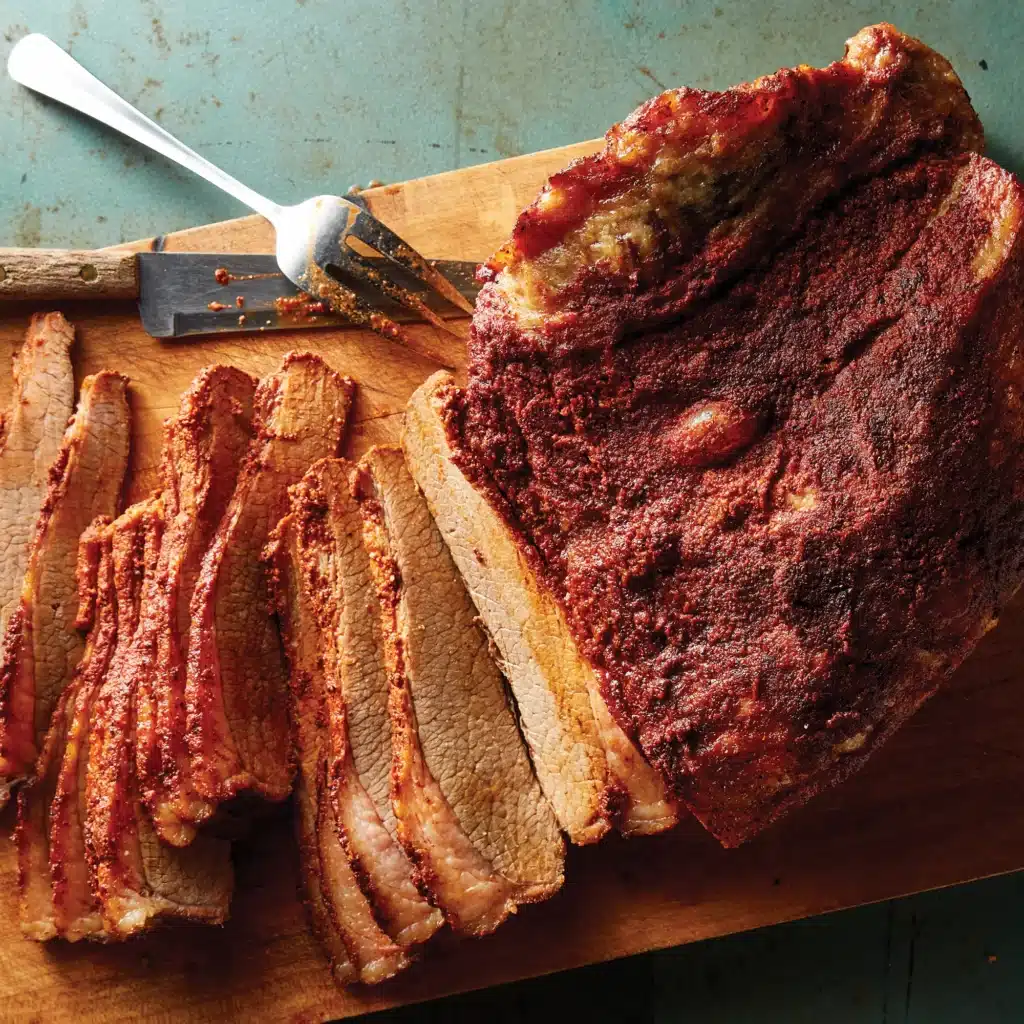
Nothing quite captures the essence of slow-cooked perfection like a tender and flavorful smoked brisket. This culinary masterpiece, hailed by barbecue enthusiasts and food lovers alike, is a celebration of patience, skill, and the harmonious marriage of smoke, seasoning, and meat.
See Also: The Best Italian Pastina Recipe
Smoked Brisket
A smoked brisket is a delectable barbecue dish known for its rich and flavorful taste, achieved through a slow cooking process combining smoke, seasoning, and a well-marbled cut of meat. Brisket, a tough cut of beef from the chest area, is transformed into a tender and delicious masterpiece through the magic of smoking.
This cooking method involves low and slow cooking over indirect heat, often using wood chips or chunks to infuse the meat with a smoky aroma and deep flavours.
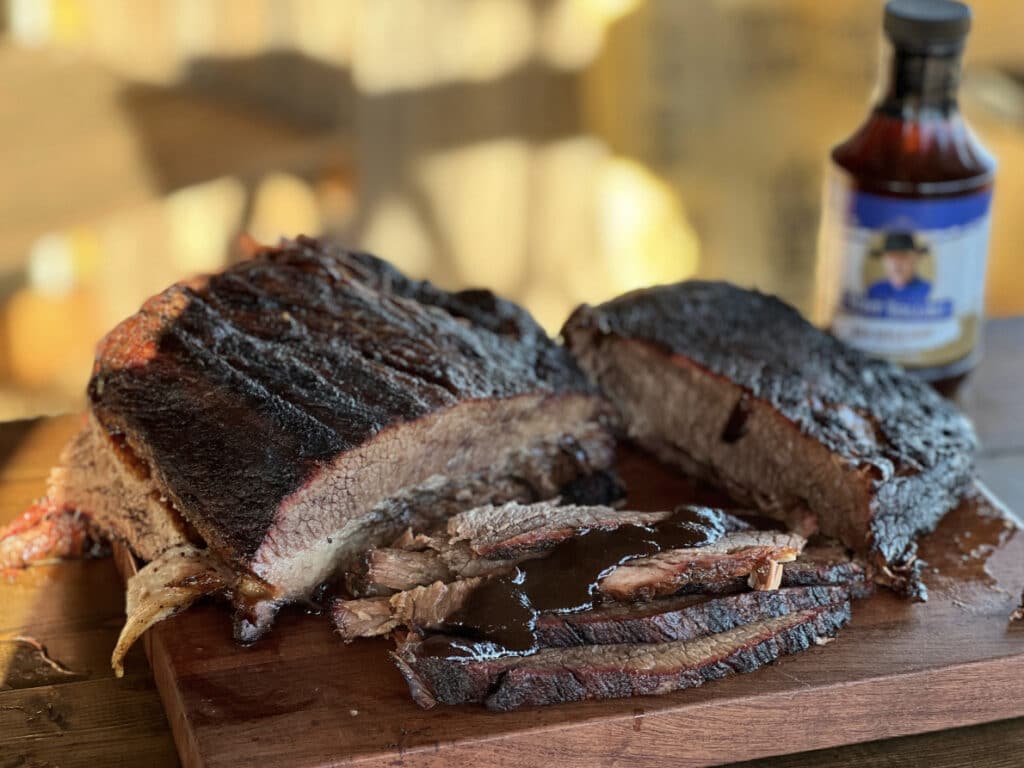
To create a smoked brisket, the meat is typically seasoned with a blend of spices, dry rubs, and marinades to enhance its taste and tenderness. The brisket is then placed in a smoker, where it undergoes a slow cooking process for several hours. The result is a melt-in-your-mouth texture, bold flavours, and a caramelized crust known as the “bark.”
Smoked brisket is a staple in barbecue culture and a favourite at cookouts, gatherings, and special occasions. Its preparation requires time and skill, making it a cherished dish often associated with a passion for grilling and a love for savouring mouthwatering, smoky flavours.
Whether served as a main dish or in sandwiches, smoked brisket is a culinary delight that celebrates the art of barbecue.
SEE ALSO: How to Make Cornflake Tart
Why brisket is a good choice for Smoking, Flavour and Tenderness Brisket
Brisket is considered an excellent choice for smoking due to its unique combination of flavour and tenderness. This beef cut comes from the cow’s chest area and consists of two distinct muscles: the leaner flat and the fattier point. Here’s why brisket shines when it comes to smoking:
- Flavour: Brisket is inherently flavorful due to its marbling—the streaks of fat that run through the meat. During the smoking process, these fat layers slowly render and melt, infusing the meat with a rich and succulent taste. The fat also helps prevent the meat from drying out, resulting in a juicy and delicious final product.
- Tenderness: While brisket is known for being a tougher cut of meat, the low and slow smoking method is ideal for breaking down its connective tissues and collagen. This extended cooking time at a low temperature transforms the tough meat into a fork-tender delicacy. The result is meat that practically falls apart, making each bite a pleasure.
- Smoke Absorption: Brisket’s texture and structure make it a great canvas for absorbing smoky flavours. As the meat cooks slowly in the smoker, it has ample time to absorb the aromatic compounds released by the wood chips or chunks. This infusion of smokiness adds a unique layer of complexity to the overall flavour profile of the meat.
- Bark Formation: The extended cooking time in the smoker also creates a flavorful crust on the exterior of the brisket, known as the “bark.” This bark is a combination of seasonings, spices, and smoke that intensifies the overall taste and provides a satisfying contrast to the tender interior.
- Versatility: The flavour of smoked brisket can be customized based on the type of wood used for smoking and the seasoning rub applied. This versatility allows pitmasters and chefs to create a wide range of flavour profiles, from sweet and spicy to smoky and savoury.
In the realm of smoked meats, brisket is often considered the pinnacle of achievement due to its challenging nature and rewarding results. It’s a testament to the artistry of smoking. This process transforms a tough cut of meat into a culinary masterpiece that captivates the palate with its exquisite taste and tenderness.
Read Also: Shrimp Lo Mein Recipe: Best Seafood Noodle Delicacy
Why Brisket is a Good Choice for Smoking, Flavour and Tenderness Briske on Selecting a High-Quality Brisket
Selecting a high-quality brisket is essential to achieving a successful and flavorful smoked result. Here are some tips to help you choose the best brisket for your smoking endeavours:
- Choose the Right Cut: A brisket has two main parts—the flat and the point. The flat is leaner and more uniform, while the point has more marbling and flavour. Decide which part suits your preference and cooking style.
- Look for Marbling: Marbling is the streaks of fat that run through the meat. Opt for a brisket with good marbling, as this fat will render during smoking and contribute to flavour and tenderness.
- Check for Firmness: A high-quality brisket should feel firm to the touch. Press your fingers gently on the meat; it should spring back slowly. Avoid cuts that feel too soft or overly rigid.
- Thickness Matters: A thicker brisket will generally result in a more tender and moist end product. Look for a cut that is uniform in thickness, especially if you’re aiming for even cooking.
- Colour: The colour of the brisket should be a deep red, indicating that it’s fresh. Avoid briskets with a dull or faded colour.
- Avoid Excessive Trimming: Some trimming is normal, but avoid briskets that have been overly trimmed, as this can affect both flavour and tenderness. Look for cuts with a reasonable amount of fat left on them.
- Grade of Meat: If available, choose a brisket with a higher grade of meat, such as USDA Prime or Choice. These grades indicate higher quality and better marbling.
- Check the Bone: If your brisket comes with the bone still attached, ensure that it’s intact and not excessively exposed. The bone helps maintain moisture and flavour during smoking.
- Ask Your Butcher: If you’re unsure about selecting a brisket, don’t hesitate to ask your local butcher for assistance. They can guide you to the best options and provide valuable insights.
- Consider Your Cooking Time: If you’re planning a longer smoking time, you might opt for a larger brisket. However, for quicker cooking, a smaller cut could work better.
Remember that choosing a brisket is an important step that sets the foundation for a successful smoked dish. By paying attention to marbling, texture, colour, and other factors, you can ensure that you’re working with a high-quality piece of meat that will yield a flavorful and tender smoked brisket.
Read Also: Beetroot Soup Recipe
How to Prepare the Smoked Brisket
Preparing a brisket for smoking involves several key steps to ensure the meat absorbs flavours, becomes tender, and develops a delicious crust. Here’s a step-by-step guide to help you prepare the brisket:
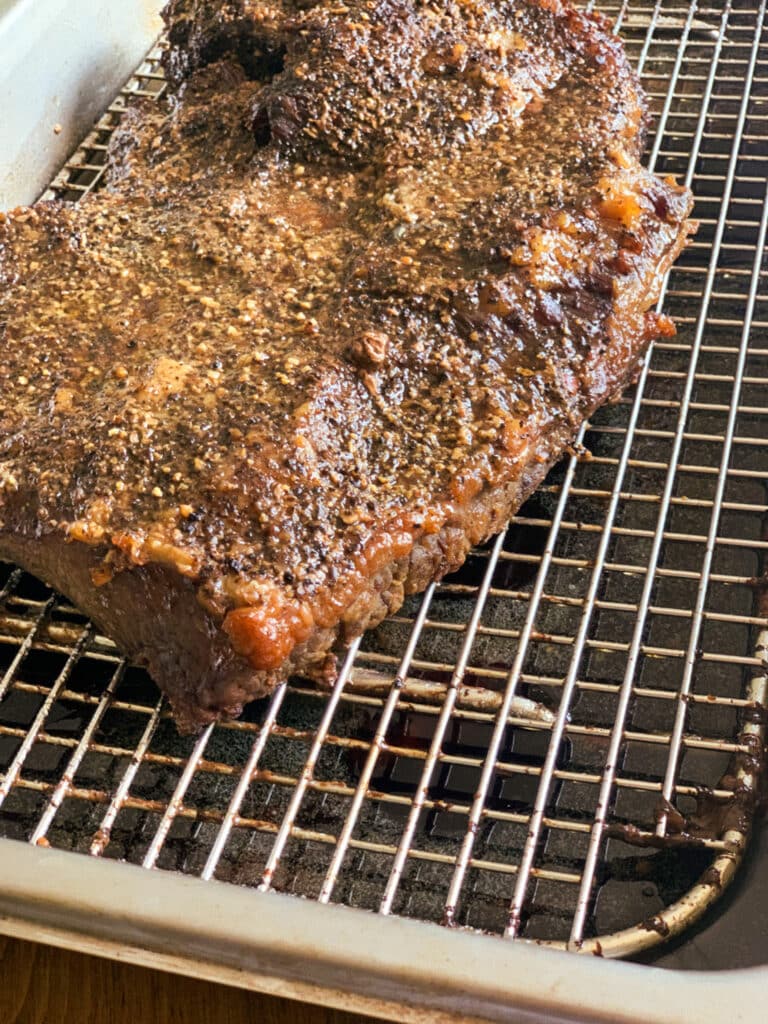
- Trim Excess Fat: Begin by trimming excess fat from the brisket, leaving a thin layer of fat to help keep the meat moist during smoking. Trim any tough connective tissue as well.
- Seasoning Rub: Create a dry seasoning rub by mixing together your preferred spices, herbs, salt, pepper, and other flavourings. Rub the seasoning mixture generously onto all sides of the brisket. Allow the seasoned brisket to rest for about 30 minutes to an hour, or refrigerate it overnight for more intense flavour penetration.
- Optional Marinade: If you prefer, you can marinate the brisket with a liquid marinade for a few hours before applying the dry rub. Marinades can add an extra layer of flavour and help tenderize the meat.
- Rest at Room Temperature: Before placing the brisket in the smoker, allow it to come to room temperature for about 30 minutes. This helps ensure even cooking.
- Prepare the Smoker: Preheat your smoker to the desired temperature. A low and slow cooking temperature of around 225°F (107°C) is recommended for brisket. Use wood chips or chunks to generate smoke and infuse flavour.
- Water Pan: Place a water pan in the smoker to help maintain moisture levels and prevent the meat from drying out.
- Placement in Smoker: Position the brisket on the smoker grates, fat side up. The fat will render as the brisket cooks, basting the meat and keeping it moist.
- Monitoring the Internal Temperature: Insert a meat thermometer into the thickest part of the brisket without touching the bone. Monitor the internal temperature throughout the smoking process. Aim for an internal temperature of around 195°F to 205°F (90°C to 96°C) for optimal tenderness.
- Wrap in Foil (Optional): Some pitmasters choose to wrap the brisket in aluminium foil once it reaches a certain temperature (usually around 160°F or 71°C). This helps accelerate the cooking process and prevents the meat from drying out.
- Resting Period: Once the brisket reaches the desired internal temperature, remove it from the smoker and let it rest, wrapped in foil, for about 30 minutes to an hour. This allows the juices to redistribute throughout the meat.
- Slicing and Serving: Slice the brisket against the grain to ensure tenderness. The bark on the outside will be flavorful and slightly crispy, while the interior should be juicy and tender.
By following these steps, you can prepare a smoked brisket that’s bursting with flavour, perfectly tender, and sure to impress your guests with its smoky aroma and irresistible taste.
Types of Smokers and Their Pros and Cons
Several types of smokers are available, each offering a unique approach to achieving delicious smoked dishes. Here are some common types of smokers, along with their pros and cons:
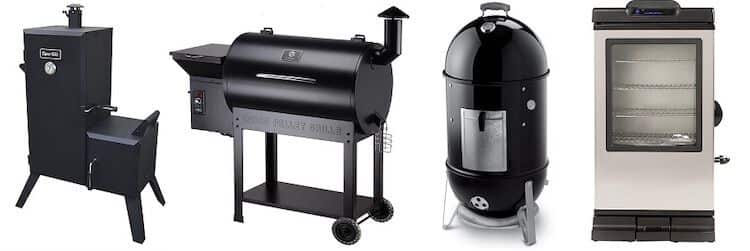
- Charcoal Smokers:
- Pros: Charcoal smokers provide an authentic smoky flavour and allow for precise temperature control. They can reach high temperatures for searing and low temperatures for slow smoking.
- Cons: They require more attention and maintenance than other smokers. Controlling temperature can be challenging for beginners.
- Electric Smokers:
- Pros: Electric smokers are user-friendly and convenient. They maintain consistent temperatures and are easy to operate. Some models even have digital controls for precise adjustments.
- Cons: They may not produce as intense a smoky flavour as other types of smokers. Some purists argue that electric smokers lack the traditional charcoal or wood-fired taste.
- Pellet Smokers:
- Pros: Pellet smokers offer the convenience of electric smokers with the flavour of wood-fired cooking. They use wood pellets as fuel and provide consistent temperature control.
- Cons: Pellet smokers can be more expensive upfront due to the cost of the pellet system. Some models require electricity to function.
- Gas Smokers:
- Pros: Gas smokers are easy to use and provide good temperature control. They offer a quicker setup compared to charcoal or wood smokers.
- Cons: They may not offer the same level of smoky flavour as charcoal or wood smokers. Propane tanks need to be refilled or replaced.
- Offset Smokers:
- Pros: Offset smokers allow for traditional smoking with charcoal or wood while controlling the smoke and heat distribution. Experienced pitmasters favour them for their versatility.
- Cons: Learning to manage fire, airflow, and heat distribution can be challenging for beginners. The setup process may take longer compared to other types of smokers.
- Vertical Water Smokers:
- Pros: Vertical water smokers are compact and suitable for small spaces. They use a water pan to help maintain moisture and produce tender smoked dishes.
- Cons: They have limited cooking space and may not be ideal for larger cuts of meat. Temperature control can be less precise than with other types of smokers.
- Drum Smokers (Ugly Drum Smokers):
- Pros: Drum smokers are simple to build and offer excellent temperature stability. They can accommodate large amounts of meat and are known for producing great results.
- Cons: Building or purchasing a drum smoker requires some DIY skills. They may lack some of the additional features found in other types of smokers.
Choosing the right type of smoker depends on your experience level, cooking preferences, and convenience. Each type has its advantages and disadvantages, so consider factors such as flavour, ease of use, temperature control, and available space when deciding.
Step-by-Step Smoked Brisket Process
Smoking meats requires patience and attention to detail to achieve that perfect balance of flavours, tenderness, and smoky goodness. Here’s a step-by-step guide to the smoking process:
Step 1: Preparing the Meat
- Select the meat: Choose your meat cuts, such as brisket, ribs, pork shoulder, or chicken, and ensure it’s properly trimmed and seasoned.
- Dry brining (optional): Apply a dry rub or marinade to the meat. Allow it to sit in the refrigerator for a few hours or overnight. This helps the flavours penetrate the meat and enhances tenderness.
Step 2: Preparing the Smoker
- Choose wood chips or chunks: Select the type of wood chips or chunks that will complement the flavour of your meat. Popular choices include hickory, mesquite, apple, cherry, and oak.
- Preheat the smoker: Start by preheating your smoker to the desired temperature. Most smoking is done at low and slow temperatures around 225°F (107°C).
- Add water pan (if applicable): If your smoker has a water pan, fill it with water. This helps maintain moisture and prevents the meat from drying out.
Step 3: Smoking the Meat
- Place the meat in the smoker: Position the meat on the grates, ensuring enough space between pieces for proper air circulation.
- Add wood chips or chunks: Add soaked wood chips or chunks to the smoker box or directly onto the charcoal. This produces a smoky flavour that infuses the meat.
- Monitor temperature: Keep a close eye on the smoker’s temperature using a reliable thermometer. Adjust the airflow, dampers, or burner settings to maintain a consistent temperature.
Step 4: Smoking Process
- Monitor smoking time: Different cuts of meat require different smoking times. Refer to smoking charts or recipes for guidance on how long to smoke your specific meat.
- Baste or mop (optional): Some pitmasters choose to baste or mop the meat with a mixture of liquid and spices to enhance flavour and moisture.
Step 5: Checking Doneness
- Check internal temperature: Use a meat thermometer to check the internal temperature of the meat. Different meats have specific target temperatures for doneness.
- Consider the “smoke ring”: A pinkish layer on the outer edge of the meat, known as the smoke ring, indicates proper smoke penetration. It’s a desirable characteristic of smoked meats.
Step 6: Resting and Serving
- Remove from the smoker: Once the meat reaches its desired internal temperature, carefully remove it from the smoker and place it on a clean cutting board.
- Resting period: Let the meat rest for about 15 to 30 minutes. This allows the juices to redistribute throughout the meat, ensuring tenderness.
- Slicing and serving: Slice or pull the smoked meat as desired. Serve it immediately to enjoy the full flavour and tenderness of smoking.
Remember, the smoking process can vary based on the type of smoker you’re using, the meat you’re cooking, and your personal preferences. Experimentation and practice will help you master the art of smoking and create mouthwatering, smoky dishes.
See Also: Vegan Tacos Recipe
Signs of a Properly Smoked Brisket, such as the Desired Colour, Tenderness, and Flavour
Recognizing a properly smoked brisket involves assessing its colour, tenderness, and flavour. Here are the signs to look for:
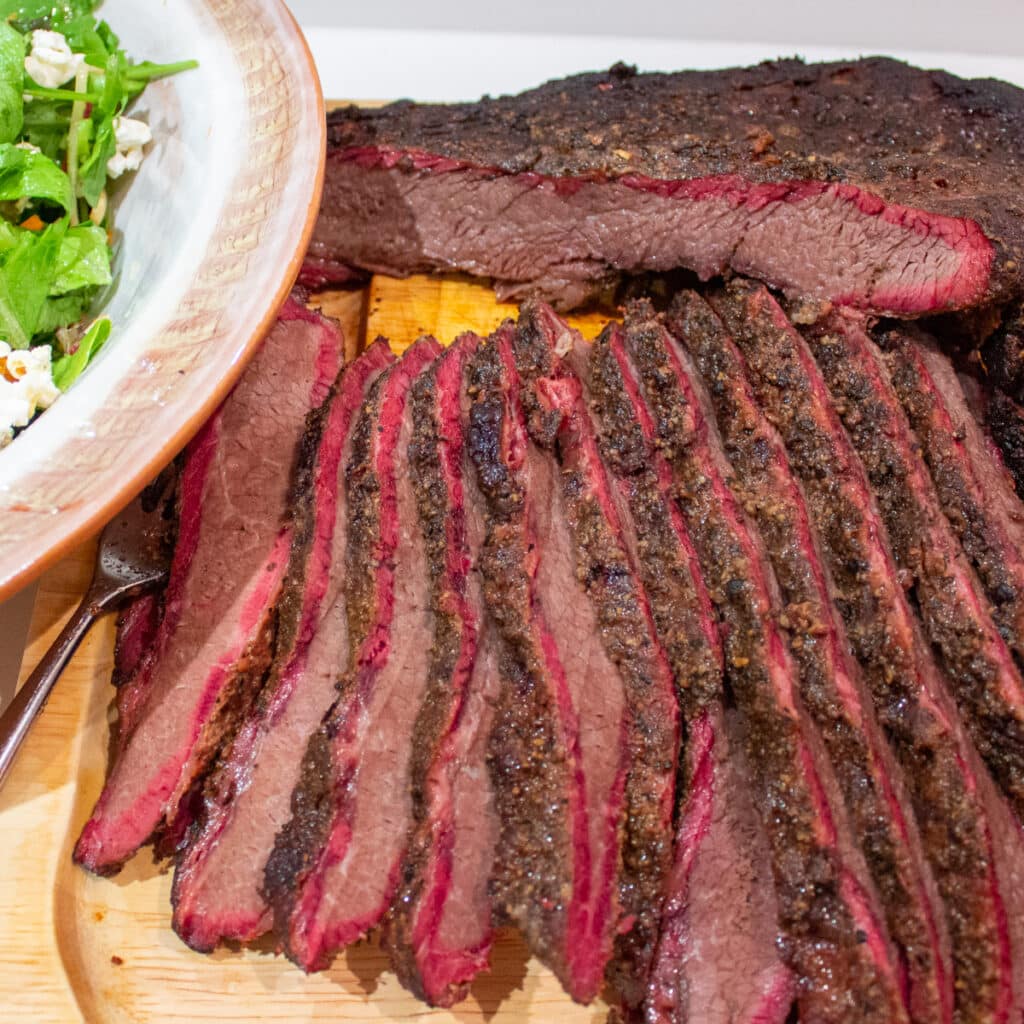
1. Colour:
- Deep Smoke Ring: A properly smoked brisket will have a distinct pink or reddish layer beneath the outer surface known as the smoke ring. This ring indicates that the smoke flavour has penetrated the meat.
- Rich Exterior Colour: The exterior of the brisket should have a deep, caramelized colour. It might appear slightly darker due to the caramelization of the rub and the smoke.
2. Tenderness:
- Easily Inserted Probe: When you insert a meat thermometer probe or a fork, it should slide into the meat with little resistance. The meat should feel tender to the touch.
- Pull Test: If you gently pull the brisket with tongs, it should easily pull apart without significant effort. The meat fibres should separate without being mushy.
- Clean Slice: When you slice the brisket, the knife should glide through the meat without shredding or tearing it apart. The slices should hold their shape and not fall apart.
3. Flavour:
- Balanced Smoke Flavour: The smoke flavour should be present but not overpowering. It should complement the natural flavours of the meat and the seasoning.
- Seasoned throughout: The seasoning should be evenly distributed, enhancing the taste of every bite.
4. Juiciness:
- Moist Meat: A properly smoked brisket will be moist and juicy, not dry. The rendering of fat and collagen during the smoking process contributes to the meat’s juiciness.
5. Internal Temperature:
- Proper Internal Temperature: The internal temperature of the brisket should be in the range of 195°F to 205°F (90°C to 96°C) when using a meat thermometer. This temperature range ensures that the collagen has fully broken down, leading to a tender texture.
6. Smell:
- Smoky Aroma: The brisket should have a rich, smoky aroma that’s not overly strong or acrid.
7. Bark Formation:
- Crisp Bark: The outer layer of the brisket, known as the “bark,” should be firm and slightly crispy. This bark develops from the seasoning and smoke interacting with the meat’s surface.
Remember that achieving the perfect brisket may take practice and experimentation. Factors such as the type of smoker, wood, cooking time, and meat quality all play a role in the final result. Over time, you’ll develop an intuition for recognizing the signs of a properly smoked brisket based on your preferences and experience.
Read Also: Lemon Pepper Wings Recipe
Smoked Brisket Recipes
Here are two popular brisket smoking recipes for you to try:
1. Classic Smoked Brisket: Ingredients:
- 1 whole beef brisket (10-12 pounds)
- 1/4 cup kosher salt
- 1/4 cup black pepper
- 1/4 cup paprika
- 1/4 cup brown sugar
- 2 tablespoons garlic powder
- 2 tablespoons onion powder
- 1 tablespoon cayenne pepper (adjust to taste)
- Wood chunks or chips (hickory, oak, or mesquite)
2. Spicy Peri Peri Smoked Brisket: Ingredients:
- 1 whole beef brisket (10-12 pounds)
- 1/4 cup peri peri sauce (store-bought or homemade)
- 2 tablespoons olive oil
- 2 tablespoons smoked paprika
- 1 tablespoon garlic powder
- 1 tablespoon onion powder
- 1 tablespoon brown sugar
- 1 teaspoon cayenne pepper (adjust to taste)
- Salt and black pepper to taste
- Wood chunks or chips (mesquite or oak)
Serving the Smoked Brisket
Serving smoked brisket is a delightful experience that involves showcasing the flavorful and tender meat you’ve worked hard to create. Here are some tips for serving your perfectly smoked brisket:
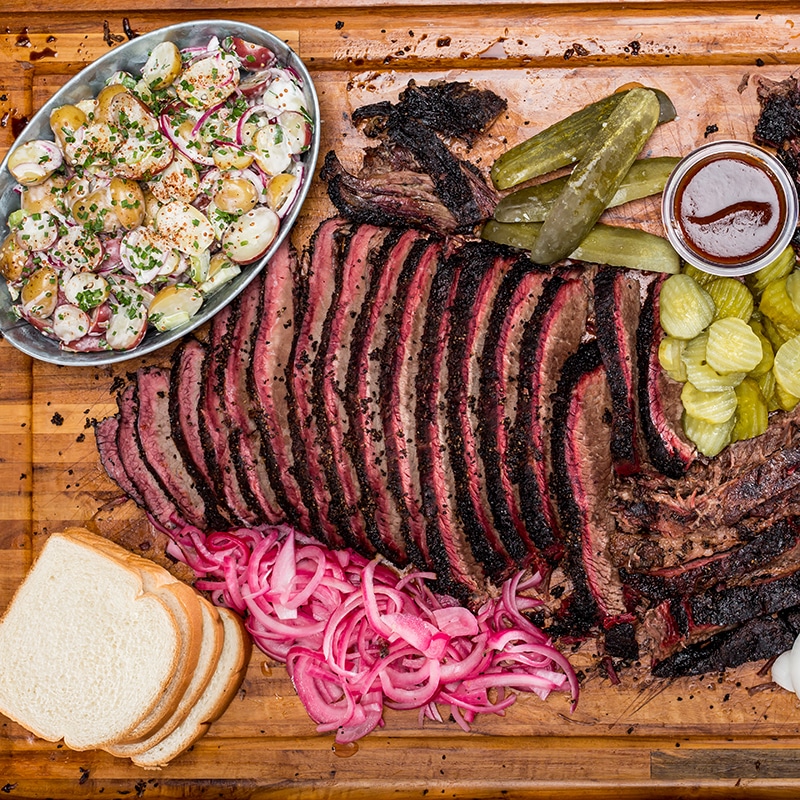
1. Slicing: Properly slicing the smoked brisket is key to serving it beautifully. Slice against the grain for the most tender and enjoyable bites. The grain of the brisket runs in different directions in different sections, so be sure to adjust your slicing accordingly.
2. Presentation: Arrange the sliced brisket on a serving platter, arranging it in an organized manner. You can arrange slices from both the brisket’s flat and point sections to offer various textures and flavours.
3. Sauces: Provide a selection of barbecue sauces or condiments for guests to enjoy alongside their brisket. Classic options like a tangy barbecue sauce or a spicy peri peri sauce can complement the smoky flavours.
4. Sides: Offer a variety of side dishes to complement the hearty brisket. Coleslaw, potato salad, macaroni and cheese, cornbread, baked beans, and pickles are popular choices that balance the rich flavours of the meat.
5. Bread: Serve the brisket with fresh rolls or slices of bread. Guests can create their own sandwiches by piling brisket onto the bread and adding toppings and sauces.
6. Garnishes: Fresh herbs, such as parsley or cilantro, can add a burst of colour and freshness to the presentation. They also provide a contrast to the rich and smoky flavours of the brisket.
7. Serving Utensils: Provide tongs or serving forks for guests to easily grab their desired portions of brisket.
8. Family-Style: For a more casual gathering, consider serving the brisket family-style on a large platter. Guests can help themselves and create their own plates.
9. Buffet Setup: If you’re serving a larger group, set up a buffet-style station where guests can choose their slices of brisket, sides, and sauces.
10. Accommodate Dietary Preferences: Remember to offer alternative options for guests with dietary restrictions, such as vegetarian or gluten-free sides.
11. Enjoy the Experience: Encourage your guests to savour the brisket’s smoky aroma, tenderness, and flavour. Sharing a meal of perfectly smoked brisket is a culinary experience to remember.
Whether it’s a casual backyard barbecue or a special occasion, serving smoked brisket with care and attention to detail enhances the overall dining experience and ensures that your guests thoroughly enjoy the results of your smoking endeavour.
Smoked brisket is a culinary masterpiece that embodies the art of low-and-slow cooking, transforming a tough cut of meat into a tender and flavorful delight. The process of smoked brisket is a labour of love, requiring patience, skill, and attention to detail.
From selecting the right cut of meat to mastering the smoking technique, every step contributes to creating a dish that’s truly remarkable.
The choice of wood, the blend of seasonings, and the method of smoking all play a crucial role in achieving that perfect balance for a good smoked brisket. Whether you opt for a classic rub or an adventurous marinade, the result is a dish that’s rich in flavour, with each bite telling the story of your culinary prowess.
Serving smoked brisket is an experience that brings people together. It’s more than just a meal; it’s a celebration of the time and effort invested in creating something extraordinary.
As friends and family gather around the table to savour the succulent slices of meat, the air filled with the aroma of smoky goodness, the joy of sharing such a dish is truly unmatched.
Read Also: 4+ Easy Fish Pie Recipes You Should Try Out This Year
FAQs for Smoked Brisket Recipes
How long does it take to smoke a brisket?
The general rule of thumb is to plan on between 30 and 60 minutes per pound. For example, a 16-pound brisket cooked at 275 degrees Fahrenheit will take between 10 and 12 hours. The entire process, from trimming, injection, seasoning, and cooking, will take between 18 and 20 hours.
How is smoked brisket cooked?
We smoke brisket at 225°F. Cooking it low and slow gives you the juiciest, most delicious BBQ brisket you will ever eat. Smoke unwrapped until your brisket temperature reaches 165°F. Then, wrap it in foil. Once your smoked brisket internal temp reaches 205°F, it’s ready. Use a meat thermometer for the best results!
How to cook a brisket for beginners?
Trim your brisket. …
Season your brisket simply but liberally. …
Get your smoker set to 225°F to 250°F, or rig up your own grill to serve as a smoker with hardwood chips and indirect heat. …
Place your brisket fat-side up in the smoker. …
Cook through the stall.
What is the best method for cooking a brisket?
You can use a dedicated smoker, a charcoal grill with wet wood chips or a gas grill with wet wood chips set for indirect heat. It’s important to note that BBQ is the process of low, slow dry heat cooking. Grilling is high heat, fast cooking, it’s not BBQ. Cook the brisket for 7 to 10 hours.
Is smoking brisket difficult?
Brisket is a notoriously difficult cut of meat to master. Many amateur pitmasters have turned a 4lb brisket into a 4lb hunk of beef jerky. You shouldn’t let these horror stories put you off, though.



